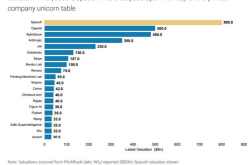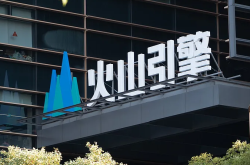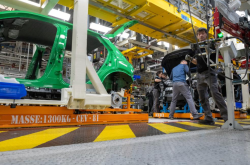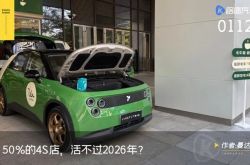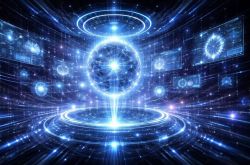What is Physical AI, the New Frontier Favored by Industry Giants?
![]() 08/04 2025
08/04 2025
![]() 486
486
As artificial intelligence's tendrils extend from the virtual realm into the physical world, a cognitive revolution regarding reality and simulation is unfolding. NVIDIA founder Jensen Huang's introduction of the "Physical AI" concept at the third Chain Expo unveils a novel paradigm for AI development – breaking through computational barriers with GPU acceleration technology, deeply integrating physical laws and chemical reactions with real-world data, empowering AI to make decisions akin to human scientists, based on established principles.

This evolution not only advances the ultimate goal of CAE (Computer-Aided Engineering) to simulate the real world but also disrupts the traditional AI path dependency on massive data training. As digital twin technology maps material deformation, fluid dynamics, and even life metabolic processes with precision, Physical AI emerges as a "builder of the digital twin world," reconstructing fields like industrial design and climate change research, quietly expanding humans' cognitive boundaries of complex systems.
01. Scientific Discovery Enters the High-Speed Rail Era

Envision Physical AI as a "digital bridge" spanning the virtual and real. While traditional AI still searches for patterns in a sea of data, Physical AI holds the "treasure map" of scientific laws, constructing a parallel universe within computers that fully adheres to physical rules. This technological revolution redefines how humans perceive the world, akin to equipping scientists with "digital prophecy glasses."
Imagine designing a safer mobile phone battery. The traditional approach involves repeated prototyping and explosion risk testing, a process that may span years. Physical AI, however, draws from "knowledge kits" like "Principles of Electrochemistry" and "Laws of Thermodynamics," constructing a precise microcosm in digital space: the migration trajectory of lithium ions in the electrolyte conforms to the diffusion equation, electrode material crystal structure changes follow quantum mechanics principles, and even battery heating's heat conduction process is meticulously calculated. This simulation's precision reaches atomic levels, akin to building a "virtual battery manufacturing machine" within a computer.
GPU chips serve as the "super engine" of this transformation. When Physical AI calculates turbulence around aircraft wings, the GPU simultaneously processes millions of fluid element trajectories. When simulating seismic wave propagation in underground rock formations, the GPU's parallel computing power reduces models that once required supercomputers weeks to complete to a few hours. This computational efficiency leap enables "digital twin" technology to transition from concept to practical application – before construction, the Shanghai Tower used Physical AI to simulate structural stress during typhoons, and Tesla factories' robotic arms have completed millions of grasping tests in a virtual environment.
This technological breakthrough's impact extends beyond efficiency gains. When AI understands basic laws like "carbon atoms combine with oxygen at high temperatures to form carbon dioxide," it independently deduces new material synthesis paths without awaiting laboratory trial-and-error results. In medicine, Physical AI simulates drug molecule binding to human proteins, accurately predicting side effects; in environmental protection, it constructs a "digital mirror" of Earth's climate, enabling scientists to predict glacier melt's sea-level impact a decade in advance.
Physical AI's true revolution lies in enabling humans to "digitally rehearse the future." Like mathematicians proving theorems through formula derivation, Physical AI deduces complex system evolution trends in the virtual world based on known scientific laws. This paradigm shift from "data-driven" to "principle-driven" accelerates scientific discovery from the "horse-drawn carriage era" to the "high-speed rail era." As engineers perfectly replicate the physical world from molecular vibration to urban transportation in computers, Physical AI becomes a "digital telescope" for human exploration of the unknown.
02. Domestic Physical AI Industry Chain Takes Shape
The domestic Physical AI industry chain is accelerating the formation of a full-link ecosystem, from bottom-level perception to upper-level applications, leveraging technological breakthroughs as a fulcrum. This process not only fulfills the mission of domestic substitution for industrial software but also nurtures the potential for overtaking in the race through deep integration of physical fields and artificial intelligence.
Physical AI's core lies in combining basic physics principles with AI technology to construct a digital mirror of the real world through simulation, perception, and other links, thereby solving complex engineering problems. Industry chain formation requires upstream-downstream coordination. SDIC's proposed "simulation-perception-robot" benefit logic reveals this ecosystem's key links.
Suochen Technology's "Tiangong Kaiwu Platform" embodies this concept – based on generative Physical AI and real-scene rendering technology, the platform enables multi-physics field design, simulation, and optimization under four-dimensional spacetime coupling. It supports rapid real-scene construction and physical field interaction simulation while verifying robot, intelligent driving, and other scenarios through virtual training, providing industrial users with an integrated "development-deployment" Physical AI toolset. This deep integration of computational physics with AI positions it as a domestic solution comparable to NVIDIA's Omniverse, marking domestic enterprises' potential to compete with international giants in Physical AI basic platforms.
At the perception layer, Orbbec provides 3D visual data support for the ReKep system through the RGB-D camera FemtoBolt, optimizing robot movements and complex interactions, highlighting high-precision sensing devices' necessity for Physical AI implementation. At the application layer, industrial digital twin vendors like Nantech integrate Physical AI with actual industrial scenarios through solutions, driving technology from the laboratory to the production front line.
As a simulation layer core player, Suochen Technology has not only constructed the "operating system" of Physical AI through the Kaiwu Platform but also accelerated industry chain integration through mergers and acquisitions – acquiring a 55% stake in Ningbo Maisjie in late 2024 to complement dynamic environment perception and end-cloud coordination capabilities; planning to acquire a 51% stake in Beijing Likong Yuantong in early 2025 to strengthen industrial data collection and storage capabilities, gradually building a full-link closed loop from "physical field perception-simulation modeling-virtual training-decision-making closed loop," providing key pieces for industry chain improvement.
Currently, the global industrial simulation software market is undergoing changes, with Synopsys' acquisition of ANSYS approved, heralding international giants' landscape reshaping, which also brings challenges and opportunities for domestic enterprises. As Suochen Technology Chairman Chen Hao stated, Physical AI is a "game-changing technology," and even at the 0-to-1 stage, its value to customers far exceeds expectations.
With the explosion of demand for high-precision simulation and virtual training in scenarios like the low-altitude economy and new energy, Physical AI's role as industry infrastructure becomes increasingly apparent. Domestic enterprises are embracing an opportunity for overtaking in the race, leveraging their deep understanding of local industry needs and advantages in physical field simulation data accumulation.
- End -

